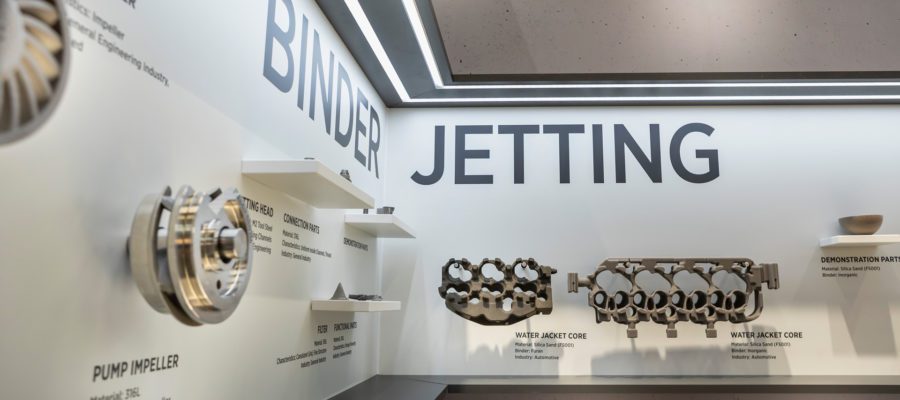Most people associate 3D printing with laser technology, binder jetting is an additive manufacturing format that doesn’t involve lasers. And that fact is one of the advantages of binder jetting for many 3D printing applications.
What is Binder Jetting?
Binder jetting uses a liquid binding agent which is deposited onto a powder bed to bond layers of powder material to create a part layer by layer. Binder jetting allows for the use of a variety of print materials, especially metals and sand.
What is the Binder Jetting Process?
Like other 3D printers, binder jetting machines construct a part on a build platform. A roller spreads a layer of powder from the powder supply in the powder bin onto the build platform. The binder jetting print heads deposit a binding agent onto the layer of powder according to the specification of your digital CAD model. When the binding layer finishes, the build platform lowers and the printer’s roller spreads another layer of powder onto the build platform. The part is built, layer by layer, until it is complete.
Post Processing of Binder Jet Printed Parts
When the final layer of the print is complete, the part is left to cure and strengthen. The part is then taken out of the powder bed and compressed air is used to remove excess powder.
Parts made from sand, including molds, generally need no further post processing. Most metal parts are put into a sintering furnace to bond the powder metal and burn off the binder. If specified, metal part finishes can be further refined with sandblasting and polishing.
Benefits of Binder Jetting
Binder jetting may not be as common as other 3D printing process, but it has many advantages over other process.
Larger Build Volumes
With no lasers involved in the process, the absence of heat means there’s no differential cooling and the associated warping. That means you can print multiple parts, even on top of each other, in a single print run.
Faster Output
Binder jet printers can produce parts as much as 100 times faster than powder bed fusion printers. This also makes them a more cost efficient option to traditional manufacturing techniques, like casting and forging.
No Support Structure Needed
As each part is takes shape in a bed of powder, there is no need to include a support structure for most binder jetting prints. That reduces the post-processing time too.
Lower Costs
The higher build volumes from a single pass, faster post processing and lower materials costs due to there being no requirement for a support structure, all contribute to making binder jetting a more cost effective additive manufacturing process.
Easier Customization, including Accurate, Complex Parts
Binder jetted parts are highly accurate and can be ready for end use out of the printer. The repeatable level of detail allows for the printing of small, detailed parts from one production to another. It also allows for custom print runs that are just as fast and accurate as less complex parts.
No Tooling Required
Parts produced by binder jetting do not require tooling. That adds to the speed of parts production, including in high volumes and accurate detail. And it all contributes to lower cost production costs.
Print Material Versatility & Cost Savings
The most common binder jet printing materials include metal, sand and ceramics. Printers also have MIM (metal injection molding) material compatibility. In addition, the reusability of printing powders means less material waste for even more cost savings.
Want to learn more about FDM additive manufacturing? Check out pour article Most Common FDM 3D Printing Materials.
